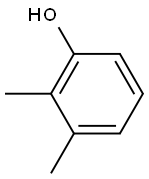Xylenol
- CAS NO.:1300-71-6
- Empirical Formula: C8H10O
- Molecular Weight: 122.16
- MDL number: MFCD01778259
- EINECS: 215-089-3
- SAFETY DATA SHEET (SDS)
- Update Date: 2025-01-13 13:53:21

What is Xylenol?
Chemical properties
White, crystalline solid. Only slightly soluble in water; soluble in most organic solvents and caustic soda solution. Combustible.
The Uses of Xylenol
Disinfectants, solvents, pharmaceuticals, insecticides and fungicides, plasticizers, rubber chemicals, additives to lubricants and gasolines, manufacture of polyphenylene oxide (2,6-isomer only), wetting agents, dyestuffs.
Production Methods
Xylenes are obtained mainly (80%) from petroleum reformate streams in the form of "mixed xylenes." A typical composition of this stream is about 18 percent p-xylene, 40 percent m-xylene, 22 percent o-xylene, and 20 percent ethylbenzene. The major chemical uses of xylene, however, require the pure isomers. The purification process involves a number of steps. First the a-xylene is separated from the other aromatics by distillation, with the meta and para isomers going overhead along with the ethylbenzene. p-Xylene can be recovered by either adsorption or crystallization processes. In the adsorption process, the stream is charged to a fixed bed of molecular sieves, and the selectively adsorbed p-xylene is recovered by washing the bed with solvent. Because the demand for p-xylene is far greater than that for m-xylene, the raffinate usually is isomerized to form more ofthe para isomer. Toluene may also be disproportionated to form equivalent amounts of benzene and xylenes without any ethylbenzene. Recently, this TOP process became more favorable. Today, it contributes to 18.5 percent of xylene production.
In 1999, the total demand for the xylenes (12.3 billion lb) was roughly comparable to that for toluene. The volume of 0-, m- and p-xylene were approximately 1.1 , 0.27, and 9.9 billion lb, respectively. The principal uses of the three xylene isomers are the production of terephthalic acid (or di-methyl terephthalate), phthalic anhydride, and isophthalic acid, respectively.
Health Hazard
Recommended Personal Protective Equipment: Organic canister mask; goggles and face shield; rubber gloves; other protective clothing to prevent contact with skin; Symptoms Following Exposure: Vapor irritates eyes, nose, and throat and readily absorbed through mucous membranes and lungs; producing general toxic symptoms (weakness, dizziness, headache, difficult breathing, twitching). Contact with skin causes temporary prickling and intense burning, then local anesthesia. Affected areas initially show white discoloration, wrinkling, and softening, then become red, then brown or black (signs of gangrene). Extensive burns may permit absorption of chemical to produce toxic symptoms described above. Ingestion causes irritation of mouth and stomach, nausea, abdominal pain, weakness, dizziness, headache, difficult breathing, and twitching; General Treatment for Exposure: Get medical attention at once following exposure to this compound. INHALATION: remove patient immediately to fresh air; irritation of nose or throat may be somewhat relieved by spraying or gargling with water-until all odor is gone; 100% oxygen inhalation is indicated for cyanosis or respiratory distress; keep patient warm, but not hot. EYES: flood with running water for 15 min.; if physician is not immediately available, continue irritation for another 15 min.; do not use oils or oily ointments unless ordered by physician. SKIN: wash affected areas with large quantities of water or soapy water until all odor is gone; then wash with alcohol or 20% glycerin solution and more water; keep patient warm, but not hot; cover chemical burns continuously with compresses wet with saturated solution of sodium thiosulphate; apply no salves or ointments for 24 hrs after injury. INGESTION: give large quantities of liquid (salt water, weak sodium bicarbonate solution, milk, or gruel) followed by demulcent such as raw egg white or corn starch paste; if profuse vomiting does not follow immediately, give a mild emetic (such as 1 tbsp. mustard in glass of water), or tickle back of throat. Repeat procedure until vomitus is free of the odor. Some demulcent should be left in stomach after vomiting. Keep patient comfortably warm; Toxicity by Inhalation (Threshold Limit Value): 45 ppm; Short-Term Exposure Limits: Data not available; Toxicity by Ingestion: Grade 2, oral LD50= 1,070 mg/kg (mouse); Late Toxicity: Damage to heart muscle, and changes in liver, kidney in rats; Vapor (Gas) Irritant Characteristics: Data not available; Liquid or Solid Irritant Characteristics: Data not available; Odor Threshold: Data not available.
Chemical Reactivity
Reactivity with Water No reaction; Reactivity with Common Materials: No reaction; Stability During Transport: Stable; Neutralizing Agents for Acids and Caustics: Not pertinent; Polymerization: Not pertinent; Inhibitor of Polymerization: Not pertinent.
Safety Profile
A poison. When heated to decomposition it emits acrid smoke and irritating fumes. See also other xylenol entries.
Properties of Xylenol
| Melting point: | 42.65°C (estimate) |
| Boiling point: | 209.6°C (estimate) |
| Density | 0.9863 (estimate) |
| vapor pressure | 71.3Pa at 20℃ |
| refractive index | 1.5321 (estimate) |
| Odor | Sweet tarry. |
| Water Solubility | 11g/L at 25℃ |
| Dielectric constant | 2.3(20℃) |
| CAS DataBase Reference | 1300-71-6(CAS DataBase Reference) |
| EPA Substance Registry System | Dimethylphenol (1300-71-6) |
Safety information for Xylenol
Computed Descriptors for Xylenol
New Products
4,4-Difluoropiperidine hydrochloride tert-butyl 9-methoxy-3-azaspiro[5.5]undecane-3-carboxylate Indole Methyl Resin N-Isopropylurea N,N-Dicyclohexylcarbodiimide(DCC) MELDRUMS ACID 5-METHYLISOXAZOLE-4-CARBOXYLIC ACID Magnessium Bis glycinate Zinc ascorbate 1-bromo-2-butyne 2-acetamidophenol 9(10H)-anthracenone Erythrosin B, 4-Piperidinopiperidine 2-((4-morpholinophenylamino) (methylthio) methylene) malononitrile 2,4-dihydroxybenzaldehyde 3-(4-morpholinophenylamino)-5-amino-1H-pyrazole-4-carbonitrile Methyl 2-methylquinoline-6-carboxylate 2,6-dichloro-4-nitropyridine 4-Bromo-2-chlorobenzonitrile 2-(benzylamino)acetic acid hydrochloride 4-(tert-Butoxycarbonylamino)but- 2-ynoic acid 3,4-dihydro-2H-benzo[b][1,4]dioxepine 1-Phenyl-1-cycloprppanecarboxylicacidRelated products of tetrahydrofuran








You may like
-
 1300-71-6 Mix Xylenol (2,4 & 2,5) 98%View Details
1300-71-6 Mix Xylenol (2,4 & 2,5) 98%View Details
1300-71-6 -
 1300-71-6 99%View Details
1300-71-6 99%View Details
1300-71-6 -
 3-(4-amino-1-oxoisoindolin-2-yl)-1-methylpiperidine-2,6-dione 98%View Details
3-(4-amino-1-oxoisoindolin-2-yl)-1-methylpiperidine-2,6-dione 98%View Details -
 614-19-7 98%View Details
614-19-7 98%View Details
614-19-7 -
 20677-73-0 (2,2-diethoxyethyl)methylamine 98%View Details
20677-73-0 (2,2-diethoxyethyl)methylamine 98%View Details
20677-73-0 -
 3-(4-(hydroxyamino)-1-oxoisoindolin-2-yl)piperidine-2,6-dione 98%View Details
3-(4-(hydroxyamino)-1-oxoisoindolin-2-yl)piperidine-2,6-dione 98%View Details -
 57381-49-4 2-bromo-4-chlorobenzonitrile 98%View Details
57381-49-4 2-bromo-4-chlorobenzonitrile 98%View Details
57381-49-4 -
 4,6-dichloropyrimidine-5-carbaldehyde 98%View Details
4,6-dichloropyrimidine-5-carbaldehyde 98%View Details
5305-40-8
